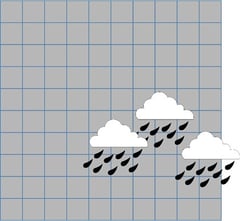The steady back-and-forth, back-and-forth motion of my wipers swooshing away the "thirty percent chance of rain" from my windshield carried me back to thoughts of forecasts and forecasting accuracy.
On the "How" of Forecasting
My thoughts wandered past a description I had heard once of what a "percent chance of rain" really meant. It went like this:
A 30 percent chance of rain means:
- There is a 30 percent chance that 100 percent of us will get wet, or
- There is a 100 percent chance that 30 percent of us will get wet, or
- There is a 70 percent chance that the weatherman is 100 percent wrong!
I recalled that, when I first heard it, I thought it was cute, but not necessarily accurate. Only later did I learn how that "X percent chance of rain" was actually calculated by forecasters.
To calculate the percent probability of precipitation, as I understand it, they take a 10-mile by 10-mile square grid and center it over the forecast target area. (See the accompanying figure.) Then, by taking into consideration factors like the size of the weather cell and other factors they believe will affect its path, they compute the likelihood of precipitation across the 100 square-mile grid.
So, in fact, they are saying precisely what the quip above states:
- There is, perhaps, an X percent chance that 100 percent of the 10X10 grid will receive precipitation, or
- There is, perhaps, a 100 percent chance that 30 percent of the 10X10 grid area will receive precipitation, or
- There is, in the alternative, a (100 – X) percent chance that their forecast is off the mark entirely.
On the Use of Technology to Improve Forecasting
As my mind continued wandering to the steady rhythm of the windshield wipers, I also recalled a statement from the meteorologists from the National Weather Service. The statement, as I recall it, originated in the early days of computer-assisted forecasting, but just as computing power was becoming cheaper and more widely available. The statement went something like this:
Give us enough computing power, and we will be able to provide you with forecasts that are always 100 percent accurate.
Of course, after supercomputers were made available to them, all they really discovered about creating accurate forecasts is that the more they knew, the more they realized that they did not even know all of the factors that influence the weather. In fact, amongst the hundreds of factors that they now know have an influence, there is no universal agreement as to how they should be weighted and applied in various forecasting circumstances.
Assuredly, more computing power has had some effect on improving weather forecasts, but—more than anything else—it has exposed what is not known in the field of forecasting and meteorology.
On the Use of Big Data
Today, advocates for the use of "big data" and "unstructured data" in business forecasting schemes are discovering the same thing. The more computing power becomes available to crunch the data, the more the folks doing the analysis recognize their shortcomings in being able to recognize all of the factors, or in knowing how to weight and apply the various factors, that might affect the forecasts.
Great for Selling Computer Systems and Forecasting Software
Today, many on the selling side of computer systems and forecasting software firmly hold to the more than 40-year-old prophecy from the National Weather Service. They, too, believe that, if we just had enough computing power, we could create flawless forecasts to drive supply chains and other business results.
On the buying side of the equation, there are also many managers and executives who have bought into this concept. The result is, more and more money is being spent on computer hardware, software and consulting services and, all too frequently, with relatively meager return on investment (ROI).
Where Are the Gains?
In the end, the computer systems' sellers prosper and the buyers stumble on with forecasts that can now tell them, with a small degree of improved accuracy, something like this: "There is a 70 percent chance that you will sell N quantity of products in the Y product line in the coming quarter, and the product mix might look like this."
This kind of forecast accuracy is suitable for managing order of magnitude decisions—like deciding on capacities and means.
However, it is not suitable for driving manufacturing and distribution execution decisions. And, relying upon such inaccurate forecasting to drive execution results in business-as-usual with overstocks, shortages, high expediting costs, firefighting, and less than adequate customer service levels.
Only by becoming truly demand-driven (by which, I do not mean, make-to-order), can a company or supply chain overcome the weaknesses that will always be inherent in forecasts—regardless of computing power and software prowess.
Those who have undertaken a truly demand-driven journey have received handsome rewards in terms of increasing profits and dramatic improvements in ROI. Why would you not want to become one of them? Big technology and big data, not required.
Contact us. We are happy to help.




